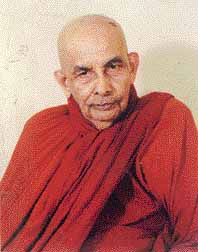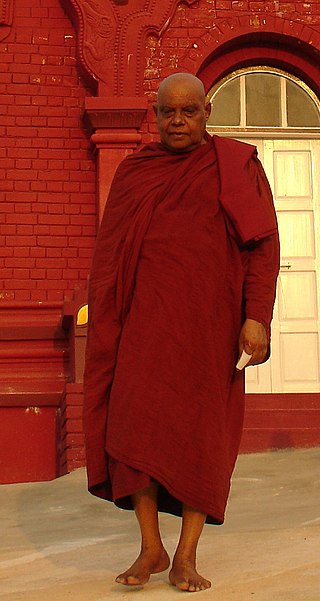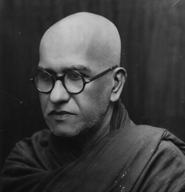
Balangoda Ananda Maitreya Thero was a Sri Lankan Buddhist monk who was one of the most distinguished scholars and expositors of Theravada Buddhism in the twentieth century. He was highly respected by Sri Lankan Buddhists, who believed that he had achieved a higher level of spiritual development. Sri Lankan Buddhists also considered Balangoda Ananda Maitreya Thero as a Bodhisattva, who will attain Buddhahood in a future life.

Bhikkhu Bodhi, born Jeffrey Block, is an American Theravada Buddhist monk ordained in Sri Lanka. He teaches in the New York and New Jersey area. He was appointed the second president of the Buddhist Publication Society and has edited and authored several publications grounded in the Theravada Buddhist tradition.

Kiribathgoda Gnanananda Thero is a Sri Lankan monk. He is the founder of Mahamevnawa Buddhist Monastery and Shraddha Media Network.

Piyadassi Maha Thera was a preacher of the Dhamma both in Sinhala and in English. He was born on 8 July 1914 at Kotahena in Colombo, Sri Lanka and was educated at Nalanda College, Colombo, thereafter at the University of Sri Lanka and the Center for the Study of World Religions at Harvard University as a research student.
Nissarana Vanaya is a meditation monastery in Sri Lanka. It is located in Mitirigala in the Western Province close to the town of Kirindiwela.

Venerable Mapalagama Wipulasara Maha Thera was a Theravada Buddhist monk in Sri Lanka. He was also an artist and sculptor who has gained fame through his sculptures of Buddha statues that are worshiped in many places within Sri Lanka and abroad. He has held Exhibitions in Soviet Russia and China in the years 1961 and 1963 respectively.

Island Hermitage on (Polgasduwa) Dodanduwa Island, Galle District, Sri Lanka is a famous Buddhist forest monastery founded by Ven Nyanatiloka Mahathera in 1911. It is a secluded place for Buddhist monks to study and meditate in the Buddhist tradition, and it contains an English and German library.
Most Ven. Matara Sri Nanarama Maha Thera was an influential Sri Lankan meditation master, scholar and forest monk of the 20th century.

Most Venerable Madihe Pannaseeha Mahathera was an eminent Sri Lankan Buddhist monk, who was the Mahanayaka of Amarapura sect from July 13, 1969, until his death on September 9, 2003.
Śrī Kalyāṇī Yogāśrama Saṁsthā, also known as the Galduwa Forest Tradition is an independent part of the Sri Lankan Amarapura–Rāmañña Nikāya Buddhist ordination line, with their headquarters in Galduva, Kahawa, Ambalangoda. They keep a strict standard of Vinaya, recognised as the strictest standard of any major organisation in Sri Lanka. It is the largest forest sect of the Sri Lankan Sangha. Their monks are easily recognized by the palm-leaf umbrella they use and by the habit of wearing the Sanghati whenever they walk outside the monastery boundaries. Remarkably for Sri Lanka, all castes are accepted for ordination. Foreign monks, who wish to become resident at one of their monasteries, are usually expected to undergo the so-called "Dalhi-Kamma" at Galduva, a short ceremony meant to reconfirm the validity of their original Upasampada according to Galduva standard. After that they are accepted according to their normal seniority.
Thero is an honorific term in Pali for senior bhikkhus and bhikkhunis in the Buddhist monastic order. The word literally means "elder". These terms, appearing at the end of a monastic's given name, are used to distinguish those who have at least 10 years since their upasampada. The name of an important collection of very early Buddhist poetry is called the Therigatha, "verses of the therīs".

Most Ven. Nauyane Ariyadhamma Maha Thera was a Sri Lankan bhikkhu and a senior meditation teacher. He was the spiritual advisor of the Sri Kalyani Yogasrama Samstha, and for many years resided at the Na Uyana Aranya. In 2011 he moved to Meetirigala Dharmayatanaya to help revitalize this long-standing place of learning and dhamma practice.

Weliwita Asaranasarana Sri Saranankara Sangharaja Thero or popularly Weliwita Sri Saranankara Thero was a Buddhist monk, who was the last Sangharaja of Sri Lanka. He was the pioneer in the revival of Buddhism in Sri Lanka, after the decline of the religion in the 17th and 18th centuries. Saranankara Thero was bestowed with the a title by king Kirthi Sri Rajasinghe in 1753, the same year he received the Upasampada and re-established the Upasampada in Sri Lanka with the help of Mahasangha in Siam. He is also credited with the establishment of Silvath Samagama, a union of monks who lived in accordance with the Buddhist monastic discipline.

Hikkaduwe Sri Sumangala Thera was a Sri Lankan Buddhist monk, who was one of the pioneers of Sri Lankan Buddhist revivalist movement in the 19th century. He did a great service to improve the Buddhist Education in the country and was the founder of Vidyodaya Pirivena, Maligakanda in 1873, which was granted the university status later in 1959 by the Government of Sri Lanka. A veteran author and a fiery orator, he was a major figure in the Panadurawadaya, a religious debate held between Christian missionaries and Buddhist monks in 1873 at Panadura, Sri Lanka. He was well versed in Sinhala, Pali, Sanskrit, English, Buddhism, history, arithmetic, and archaeology and was one of the primary sources of information on Buddhism for the success of the Panadura debate.
Mahanayaka theros are high-ranking Buddhist monks who oversee and regulate the Buddhist clergy in Theravada Buddhist countries. The title Maha Nayaka translates to English as 'Great Leader' and it is considered to be a very important position held by a monk in a Theravada Buddhist country. It is usually bestowed upon the senior Buddhist monks who are appointed the chief prelates of monastic fraternities known as Nikayas.

Palane Vajiragnana Thero was a Sri Lankan (Sinhala) scholar Buddhist monk, who founded the Siri Vajiraramaya temple in Bambalapitiya, Sri Lanka. He was also the Maha Nayaka (head) of Amarapura Sri Dharmarakshita sect for 37 years from August 5, 1918 until his death in 1955.

Warakagoda Gnanarathana Thero is a Sri Lankan Buddhist monk who is the present Mahanayaka Thero of the Asgiriya chapter of Siam Nikaya. He was appointed as the 22nd Mahanayake Thera of the Asgiriya Chapter on 7 April 2016, by the Karaka Sangha Sabha of Asgiriya chapter, after the demise of Galagama Sri Aththadassi Mahanayaka Thera. He is also the Chancellor of the Buddhist and Pali University of Sri Lanka of Sri Lanka.
Harispattuwe Ariyawanshalankara thero (1939–2014) was a Buddhist monk in Sri Lanka. He was popular as a pious monk who had delivered great service to both Buddhism and society in Sri Lanka.
Agga Maha Pandita Kotugoda Dhammawasa Thero was an eminent Sri Lankan Buddhist monk. He was the supreme Mahanayaka of Sri Lanka Amarapura–Rāmañña Nikāya and was the chief incumbent of Sri Dharmapalaramaya, Mount Lavinia.
Venerable Ampitiye Rahula Maha Thero also known as Ampitiye Sri Rahula Maha Thero, and alternatively spelled as Ampitiye Rahula Maha Thera, was a Sinhalese Buddhist monk. He held the position of Chief incumbent at the Maharagama Sri Vajiragnana Dharmayathanaya and served as a senior advisor to the Supreme Council of the Amarapura Dharmarakshitha Maha Nikaya until his death. He was known by the honorific title "Loku Hamuduruwo".











